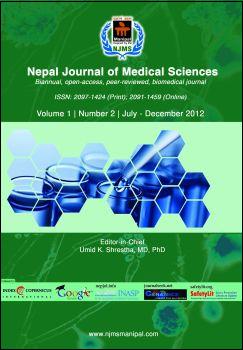Effect of anticoagulant and antiplatelet agents on outcome of AV Fistula made for hemodialysis access
DOI:
https://doi.org/10.3126/njms.v1i2.6607Keywords:
Arteriovenous fistula, antiplatelet agents, anticoagulant agents, chronic renal failureAbstract
Background: Arteriovenous fistula (AVF) is the primary mode of achieving vascular access for hemodialysis in chronic renal failure (CRF). Because of high complication rates like thrombosis, maintenance of the fistula is a major challenge. Although antiplatelets and anticoagulants are emerging rapidly for improving the outcome of AVF but fear of bleeding, hematoma, subsequent compression of AV fistula and blockade restrict their use in many dialysis centers.
Methods: Seventy five patients for whom AVF was created for hemodialysis access from Feb 2005-April 2009 in Manipal Teaching Hospital, Pokhara, Nepal were included in a retrospective study. Analysis of results was done in two different age and sex matched groups; Group I had patients where no anticoagulants or antiplatelets were used and Group II had patients in which antiplatelets/anticoagulants were used.
Results: There were 27 patients in group I and 48 patients in group II. Both the groups were followed up till 2 years post operatively to check for the patency of the fistula. AV fistula was repeated in 16 cases altogether. In group II there were 5 (10%) cases of repeat fistula while in group I it was repeated in 11 (40%) cases.
Conclusion: Judicious use of antiplatelet/anticoagulant agents in cases of AVF for hemodialysis access can be beneficial in preventing the chances of occlusion of AVF and thus helps in its long term patency.
DOI: http://dx.doi.org/10.3126/njms.v1i2.6607
Nepal Journal of Medical Sciences. 2012;1(2): 93-6
Downloads
Downloads
Published
How to Cite
Issue
Section
License
Copyright © by Nepal Journal of Medical Sciences. The ideas and opinions expressed by authors of articles summarized, quoted, or published in full text in this Journal represents only opinions of authors and do not necessarily reflect the official policy of Nepal Journal of Medical Sciences or the institute with which the author(s) is (are) affiliated, unless so specified.




